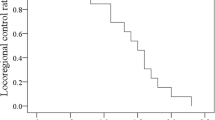Abstract
Resection of the submandibular gland is generally undertaken as an integral component of level I neck dissection for oral cancer. However, it is unclear whether lymph nodes are present within the submandibular gland which may form the basis of lymphatic spread. Our purpose was to investigate the frequency of lymph nodes within the submandibular gland, and the incidence and mechanism of submandibular gland involvement in floor of mouth cancer. Retrospective review of 177 patients with oral cancer undergoing neck dissection. Original pathology slides of floor of mouth cases were re-reviewed by two pathologists to determine frequency of intraglandular lymph nodes, and incidence and mechanism of submandibular gland involvement by cancer. The overall incidence of cervical metastases was 36.4 %, of whom 44 % had level I metastases. Level I metastases were significantly more common in floor of mouth than tongue cancers (p = 0.004). Among 50 patients with floor of mouth cancer undergoing re-review of pathology slides, intraglandular lymph nodes were not found in any of 69 submandibular glands. Submandibular gland involvement by cancer was present in two patients, representing 1 % of all oral cancers, and 4 % FOM cases. Mechanisms of involvement were direct extension, and by an apparent novel mechanism of carcinoma growing along bilateral Wharton’s ducts. Despite the high incidence of level I metastasis in floor of mouth, lymphatic metastases to submandibular gland are unlikely based on absence of intraglandular lymph nodes. We describe a previously unreported mechanism of submandibular gland involvement.



Similar content being viewed by others
References
Crile G (1987) Landmark article Dec 1, 1906: excision of cancer of the head and neck. With special reference to the plan of dissection based on one hundred and thirty-two operations. By george crile. JAMA 258:3286–3293
Buckley JG, Feber T (2001) Surgical treatment of cervical node metastases from squamous carcinoma of the upper aerodigestive tract: evaluation of the evidence for modifications of neck dissection. Head Neck 23:907–915
Takes RP, Robbins KT, Woolgar JA, Rinaldo A, Silver CE, Olofsson J, Ferlito A (2011) Questionable necessity to remove the submandibular gland in neck dissection. Head Neck 33:743–745
Jacob RF, Weber RS, King GE (1996) Whole salivary flow rates following submandibular gland resection. Head Neck 18:242–247
Ebrahim AK, Loock JW, Afrogheh A, Hille J (2011) Is it oncologically safe to leave the ipsilateral submandibular gland during neck dissection for head and neck squamous cell carcinoma? J Laryngol Otol 125:837–840
Spiegel JH, Brys AK, Bhakti A, Singer MI (2004) Metastasis to the submandibular gland in head and neck carcinomas. Head Neck 26:1064–1068
Chen TC, Lo WC, Ko JY, Lou PJ, Yang TL, Wang CP (2009) Rare involvement of submandibular gland by oral squamous cell carcinoma. Head Neck 31:877–881
Byeon HK, Lim YC, Koo BS, Choi EC (2009) Metastasis to the submandibular gland in oral cavity squamous cell carcinomas: pathologic analysis. Acta Otolaryngol 129:96–100
Razfar A, Walvekar RR, Melkane A, Johnson JT, Myers EN (2009) Incidence and patterns of regional metastasis in early oral squamous cell cancers: feasibility of submandibular gland preservation. Head Neck 31:1619–1623
Basaran B, Ulusan M, Orhan KS, Gunes S, Suoglu Y (2013) Is it necessary to remove submandibular glands in squamous cell carcinomas of the oral cavity? Acta Otorhinolaryngol Ital 33:88–92
Woolgar JA (1997) Detailed topography of cervical lymph-node metastases from oral squamous cell carcinoma. Int J Oral Maxillofac Surg 26:3–9
Shah JP, Candela FC, Poddar AK (1990) The patterns of cervical lymph node metastases from squamous carcinoma of the oral cavity. Cancer 66:109–113
DiNardo LJ (1998) Lymphatics of the submandibular space: an anatomic, clinical, and pathologic study with applications to floor-of-mouth carcinoma. Laryngoscope 108:206–214
Cain AJ, Goodlad J, Denholm SW (2001) Metachronous bilateral submandibular gland metastases from carcinoma of the breast. J Laryngol Otol 115:683–684
Rouviere H (1932) Anatomie des lymphatiques de l’homme. Maison et Cie, Paris
Bartels P (1907) Zum verstaendniss der verbreitung-smoeglichkeiten des zungenkrebses. Anat Anz 31:330–344
Dhiwakar M, Ronen O, Malone J, Rao K, Bell S, Phillips R, Shevlin B, Robbins KT (2011) Feasibility of submandibular gland preservation in neck dissection: a prospective anatomic-pathologic study. Head Neck 33:603–609
Lanzer M, Gander T, Lubbers HT, Metzler P, Bredell M, Reinisch S (2014) Preservation of ipsilateral submandibular gland is ill advised in cancer of the floor of the mouth or tongue. Laryngoscope 124:2070–2074
Acknowledgments
Helen Byrne BSc, Research Assistant, Head and Neck Cancer Fund, South Infirmary Victoria University Hospital. Salary of Ms Byrne paid for by Head and Neck Cancer Fund. The Head and Neck Cancer Fund had no role in study concept, design, data collection or analysis, writing of manuscript, or decision to submit.
Author information
Authors and Affiliations
Corresponding author
Ethics declarations
Funding
No funding.
Conflict of interest
All authors declare that they have no conflicts of interest.
Ethical approval
All procedures performed in this study were in accordance with the ethical standards of the Cork Clinical Research Ethics Committee and with the 1964 Helsinki declaration and its later amendments or comparable ethical standards.
Informed consent
As this was a retrospective study, informed consent from subjects was not required in accordance with our institutional ethical standards.
Rights and permissions
About this article
Cite this article
Fives, C., Feeley, L., Sadadcharam, M. et al. Incidence of intraglandular lymph nodes within submandibular gland, and involvement by floor of mouth cancer. Eur Arch Otorhinolaryngol 274, 461–466 (2017). https://doi.org/10.1007/s00405-016-4205-0
Received:
Accepted:
Published:
Issue Date:
DOI: https://doi.org/10.1007/s00405-016-4205-0



